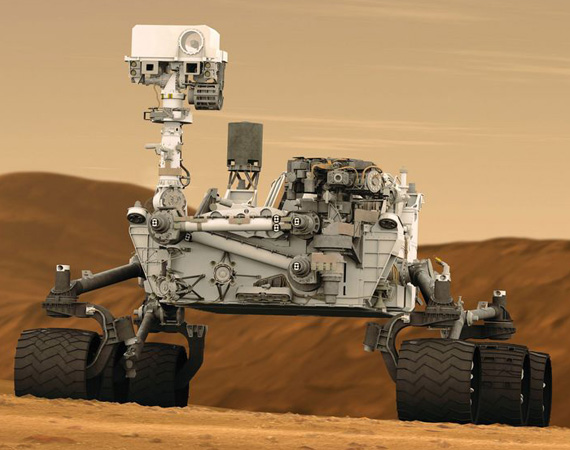Main menu
You are here
Home ›MEDIA RELEASE - Countdown Begins for Curiosity Landing
At 3:31 pm, Eastern Australian Standard Time on August the 6th, the Mars Science Laboratory (MSL) will arrive on the Martian surface. This mission delivers Curiosity, the largest and most complex rover ever to land on Mars or any other planetary body in the solar system. The mission is the result of almost a decade’s effort by NASA and the Jet Propulsion Laboratory and their partners in Spain, Finland, and Russia.
According to David Willson, a Mars Society Australia director and engineer working at NASA Ames, “whether it succeeds or fails, this mission will have an impact on the NASA Mars exploration program for years to come.”
The landing site for MSL is Gale Crater, a large and ancient impact structure, 154 kilometres across and just south of the Martian equator. The centre of Gale Crater is dominated by Mount Sharp, a huge mound of almost flat-lying thinly layered sediments 5.5 km high. MSL will land to one side of Mount Sharp and then drive towards it, photographing and analysing as it goes.
“The sedimentary deposits of the floor of Gale Crater and of Mount Sharp provide a window into several billion years of Mars history, possibly as early as 4.5 billion years ago, when Mars may have closely resembled the early Earth”, said Dr Jonathan Clarke, geologist and President of Mars Society Australia. “These rocks will help us understand the early history of Mars, whether or not it was habitable and look for signatures of life”.
MSL carries a wide range of instruments to study the environment. There are several cameras, instruments to determine the chemistry and mineralogy of the rocks, look for water and ice in the soil, identify the presence and composition of any organic matter, and study the weather and radiation levels for future crewed missions. It will carry more and better instruments than any previous Mars lander and should revolutionise our understanding of the Red Planet. Visually, Gale Crater will be quite unlike any other site so far visited on Mars. The rover will land on an ancient lake bed in the crater and climb the side of the 5 kilometre high steep sloped mountain that exposes layers of sedimentary, clay and volcanic deposits. The views and terrain will be spectacular.
Unlike earlier rovers, MSL is powered by a radioisotope thermal generator (RTG) instead of solar panels. The RTG provides power and warmth that allow MSL to operate all year ground regardless of season and the occasional dust storms. MSL is intended to last for at least a Martian year of 687 Earth days and travel for at least 10 kilometres. All being well it may last for more than a decade and travel much further than this.
However, “This is a high risk mission” says David Willson. “Many crucial aspects of the new Skycrane landing system cannot be adequately tested on Earth, and much can go wrong in the 'seven minutes of terror' between atmospheric entry and landing".
There are several connections between the MSL mission and Australia. Gale Crater is named after Walter Fredrick Gale, a 19th century amateur astronomer from Sydney. The Canberra Deep Space Tracking Station will provide important support to the crucial phases of the landing. Marion Anderson from Monash University helped NASA select the site for the MSL landing, and those of several previous missions. Dr Penny King from Australian National University, will be working with the alphaparticle X-ray spectrometer (APXS) instrument on that will determine the chemistry of the Martian surface. “It is the opportunity of a lifetime” Dr King said in an interview on The Australian National University web site on Monday.
Former MSA president Guy Murphy and author of Mars: A Survival Guide says “If successful, the mission will open a new window on the geological history of the red planet. Surface images of the slopes of Mount Sharp will show a landscape where humans could one day tread.’
For more details and comment please contact the following MSA directors:
VIC Guy Murphy – 0416 794 688
NSW Reut Abramovitch – 0406 858 646
ACT Dr Jonathan Clarke – 0418 401 612
WA Dr Graham Mann – 0400 968 588
The MSL mission web site is http://mars.jpl.nasa.gov/msl/
Mars Society Australia is a not for profit research institute incorporated in Western Australia that is active in research, education, and outreach related to the exploration of Mars.


